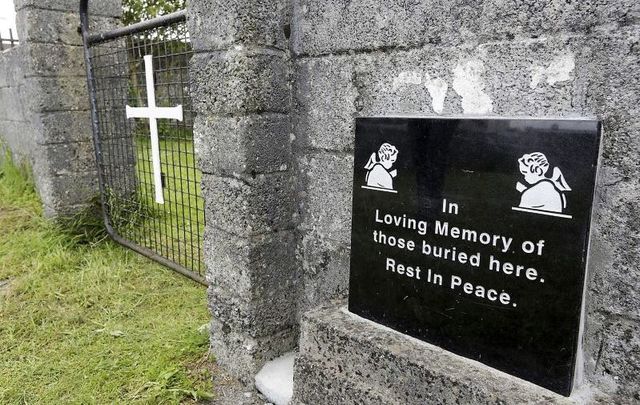Ireland’s Minister for Children and Youth presented the draft legislation on December 10
The Tuam Mother and Baby Home in Co Galway could be set to be excavated if new legislation presented by Dr. Katherine Zappone, Ireland’s Minister for Children and Youth, is passed.
Read More: Tuam babies mass grave excavation to begin in 2019
Dr. Zappone published the draft legislation, officially titled the “General Scheme of the Certain Institutional Burials (Authorised Interventions) Bill 2019," on December 10. The document is available for download online.
The drafting of this legislation is a priority for me. I know family members of the children interred at the site in Tuam have been eagerly awaiting this development & agreement on a General Scheme marks a milestone to afford those buried there the dignity & respect they deserve https://t.co/IbmeLJZMJE
— Katherine Zappone (@KZapponeTD) December 10, 2019
Read More: Tuam survivors urge Irish government to begin DNA collection
A press release said that the bill seeks to ensure Minister Zappone’s commitment to “to ensuring that respect and dignity are afforded to the children who are buried at the site in Tuam, while at the same time seeking to balance the action required to achieve this with the need to minimise disruption for those who live in the vicinity.”
Minister Zappone stated that she is pleased that Government has approved the drafting of the Bill along the lines of the General Scheme as it will create the legal basis for the course of action that Government decided should take place at the site of the former Mother and Baby Home in Tuam, Co. Galway.
The following are particularly noteworthy provisions which the Government will bring forward in the Certain Institutional Burials (Authorised Interventions) Bill 2019:
- Taking into account the Government decision of 23 October 2018, that there would be a legal basis to carry out a programme of phased, forensic standard excavation, exhumation and re-interment of remains at the site of the former Mother and Baby Home in Tuam.
- There would be a legal basis for a programme of forensic analysis of any recovered remains, providing for samples to be taken from the remains as well as from family members of the deceased for the purpose of identification of the remains.
- As no appropriate oversight structures are currently in place for such a complicated and unprecedented project, there would be a legal basis to establish an Agency to manage intervention at the site and act as a dedicated and responsive authority. Such an Agency would operate for a specific and limited duration and would cease to exist as soon as the work was complete.
- Government could authorise interventions of a similar nature to take place at current or former institutional sites other than the Tuam site, if it deemed that necessary in specific circumstances. This is notwithstanding the fact that, from a legal and ethical perspective, it is considered appropriate to leave burials undisturbed wherever possible. In this context, therefore, a burial site must be manifestly unsuitable and meet other certain defined criteria in order for Government to consider an intervention. While the conditions in Tuam have, to date, proved unique in their clear failure to provide for the dignified interment of human remains, other institutional sites may at some point fall under similar scrutiny. The approach outlined in the General Scheme ensures that further primary legislation would not have to be developed if Government was to decide that intervention was required at another burial site associated with an institution. The General Scheme provides guidance on the circumstances in which an intervention under this legislation would be justified, to ensure that the legislation is both efficient and fair.
Minister Zappone added that the Irish Government has approved the arrangements necessary to facilitate the transfer of the €2.5 million offered by the Sisters of Bon Secours Ireland towards the cost of implementing this course of action, which she plans to finalize with the Congregation so the money can be transferred as soon as possible.
Read More: Woman who brought Tuam Babies mass grave to light honored with Trinity degree
Commenting on the General Scheme, Minister Zappone said: “The drafting of this legislation is a priority for me, and I am delighted that Government supports the approach outlined in the General Scheme to deal with the various sensitive and complex issues at hand.
“I know that family members of the children interred at the site in Tuam have been eagerly awaiting this development and I am pleased that agreement on a General Scheme marks a significant milestone on our journey to afford those buried there the dignity and respect that they deserve.
“I am also mindful that local residents will be impacted by action taken at the site and I am confident that the General Scheme strikes an appropriate balance between doing what is right for the deceased, while minimising negative effects for those living nearby.
“The Certain Institutional Burials (Authorised Interventions) Bill will now be drafted along the lines of the General Scheme and I hope to publish it in Spring and bring it through the Houses of the Oireachtas as soon as possible.”
Read More: Deadline for Irish Mother and Baby Homes report extended
In 2017, the Commission of Investigation into Mother and Baby Homes and certain related matters confirmed the presence of juvenile human remains in what appears to be a sub-surface and multi-chambered structure that may have been used in the treatment of wastewater at the site of the former Mother and Baby Home in Tuam, Co. Galway.
The Commission stated that this does not provide for the dignified interment of human remains and asked that the relevant state authorities intervene.
The Tuam Mother and Baby Home is one of several similar institutions around Ireland where young, unwed mothers were sent when they became pregnant in the mid-to-late part of the 20th century. In recent years, the horrors of the institutions have come to light, thanks to the investigative work conducted by Catherine Corless.




Comments